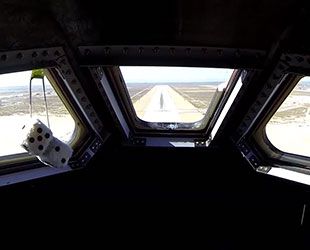October 29, 2013 — A prototype for a commercial space plane designed to taxi astronauts to Earth orbit and back performed its first drop test Saturday (Oct. 26), gliding to a successful touchdown, but immediately suffering damage due to a landing gear problem that caused the unmanned mini-space shuttle to skid off the runway, its builder said on Tuesday.
The Dream Chaser winged shuttlecraft, built by Colorado-based Sierra Nevada Corp. (SNC), carried out its first-ever autonomous approach and landing test over the weekend at Edwards Air Force Base in southern California. As the engineering test article touched down on the same runway once used by the space shuttle, the vehicle encountered an issue deploying its left-side landing gear.
"Unfortunately, we encountered an anomaly with the gear that we're still investigating, which caused the gear to not deploy properly on the left side," SNC vice president Mark Sirangelo, head of the company's space systems division, explained to reporters Tuesday (Oct. 29). "After a period of time, the vehicle was unable to continue its roll down the runway and landed down on its left side and skidded off the runway into sandy dirt."
The prototype space plane, which took several months to build, was damaged from the skid, but was otherwise left intact after the crash.

Video still of the Dream Chaser engineering test article moments after being released from the air-crane helicopter. (SNC) |
"The core structure, all of the flight controls, the rudders, the ailerons, all of those are all still attached, still working and are still part of the vehicle," Sirangelo said. "What we did lose was some of the protective coating shell off of the vehicle and some minor damage to the composites and wheel structure."
Sirangelo said he did not yet know if the spacecraft would be repaired for another unmanned free flight, or if the data collected from this drop test would be enough for them to press ahead with preparing the craft for a piloted approach and landing test next year.
"The summary of the flight was a perfect release, perfect dive [and] pull out of the dive," Sirangelo stated. "Issued commands happened exactly as the flight software in the predicted models wanted it, the approach to Edwards was uneventful and no major changes or attitude pitches were needed. The vehicle acquired the runway as expected, it came down on approach, flared, and did everything that was necessarily."
The landing "anomaly," as Sirangelo categorized it, was a singular blemish on an otherwise successful test flight, a critical milestone along SNC's development effort and bid to launch astronauts to the International Space Station by 2017. The Dream Chaser is the only winged vehicle NASA is considering as part of its commercial crew program.
The agency's two other options, Boeing's CST-100 and the Dragon by SpaceX (Space Exploration Technologies), are both capsules.
The seven-passenger Dream Chaser is 29.5 feet long (9m) and has a 22.9 feet (7m) wingspan. Its design is based on the HL-20, an early 1980's NASA concept for a lifting body re-entry vehicle.
"There has not been a lifting body flown of this type since the 1970s, some 40 years ago," Sirangelo said. "We really wanted to make sure that this design would fly and in the first five to 10 seconds [of Saturday's drop test] we knew very quickly that it was flying quite well."

According to Sierra Nevada Corp., the Dream Chaser followed its intended glide slope during its first free-flight test. (SNC) |
SNC intends the Dream Chaser to lift off vertically riding a United Launch Alliance (ULA) Atlas V rocket and return to Earth as a glider to a piloted landing on a runway.
Saturday's flight began like previous "captive-carry" tests, with the full-scale Dream Chaser prototype being lofted to altitude under an Erickson Air-Crane helicopter flying from NASA's Dryden Flight Research Center at Edwards. This time however, the test article was released to fly alone.
"Following release, the [Dream Chaser's] automated flight control system gently steered the vehicle to its intended glide slope," SNC said Saturday in a release. "The vehicle adhered to the design flight trajectory throughout the flight profile."
"Less than a minute later, Dream Chaser smoothly flared and touched down on Edwards Air Force Base's Runway 22L, right on centerline," the company stated.
The Dream Chaser test article was equipped for the flight with main landing gear modified from the U.S. Air Force's F-5E Tiger fighter jet. A different type of landing system is planned for use on spaceflights.
"While there was an anomaly with the [craft's] left landing gear deployment, the high-quality flight and telemetry data throughout all phases of the approach-and-landing test will allow SNC teams to continue to refine their spacecraft design," the company said.

Video still from a camera mounted inside the cabin of the Dream Chaser showing Runway 22L at Edwards Air Force Base in view. |
According to NASA, no one was injured during the test but emergency personnel did respond as a precaution. Dryden support staff prepared the vehicle for transport to a hangar after the incident.
"As with any spaceflight test program," SNC stated, "there will be anomalies that we can learn from, allowing us to improve our vehicle and accelerate our rate of progress."
SNC was conducting Saturday's drop test under a $227.5 million development agreement with NASA, which calls for up to five similar flights to characterize the aerodynamics of the Dream Chaser during its atmospheric approach and landing.
